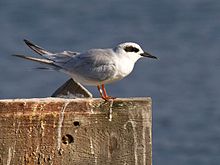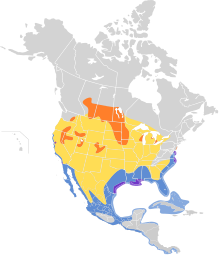| Forster's tern | |
|---|---|

| |
| Nonbreeding plumage in California | |
| Scientific classification | |
| Domain: | Eukaryota |
| Kingdom: | Animalia |
| Phylum: | Chordata |
| Class: | Aves |
| Order: | Charadriiformes |
| Family: | Laridae |
| Genus: | Sterna |
| Species: | S. forsteri
|
| Binomial name | |
| Sterna forsteri Nuttall, 1834
| |

| |
Breeding Migration Year-round Nonbreeding
| |
Forster's tern (Sterna forsteri) is a tern in the family Laridae. The genus name Sterna is derived from Old English "stearn", "tern",[2] and forsteri commemorates the naturalist Johann Reinhold Forster.[3]
It breeds inland in North America and winters south to the Caribbean and northern Central America.
This species is rare but annual in western Europe, and has wintered in Ireland and Great Britain on a number of occasions. No European tern winters so far north.
This species breeds in colonies in marshes. It nests in a ground scrape and lays two or more eggs. Like all white terns, it is fiercely defensive of its nest and young.
The Forster's tern feeds by plunge-diving for fish, but will also hawk for insects in its breeding marshes. It usually feeds from saline environments in winter, like most Sterna terns. It usually dives directly, and not from the "stepped-hover" favoured by the Arctic tern. The offering of fish by the male to the female is part of the courtship display.
This is a small tern, 33–36 cm (13–14 in) long with a 64–70 cm (25–28 in) wingspan and a weight ranging from 130 to 190 g (4.6-6.7 oz ).[4] It is most similar to the common tern. It has pale grey upperparts and white underparts. Its legs are red and its bill is red, tipped with black. In winter, the forehead becomes white and a characteristic black eye mask remains. Juvenile Forster's terns are similar to the winter adult. The call is a harsh noise like a black-headed gull.
This species is unlikely to be confused with the common tern in winter because of the black eye mask, but is much more similar in breeding plumage. Forster's has a grey centre to its white tail, and the upperwings are pure white, without the darker primary wedge of the common tern.
- ^ BirdLife International (2018). "Sterna forsteri". IUCN Red List of Threatened Species. 2018: e.T22694646A132564836. doi:10.2305/IUCN.UK.2018-2.RLTS.T22694646A132564836.en. Retrieved 12 November 2021.
- ^ "Sterna". Oxford English Dictionary (Online ed.). Oxford University Press. (Subscription or participating institution membership required.)
- ^ Jobling, James A (2010). The Helm Dictionary of Scientific Bird Names. London: Christopher Helm. p. 163. ISBN 978-1-4081-2501-4.
- ^ "Forster's Tern Identification, All About Birds, Cornell Lab of Ornithology". www.allaboutbirds.org. Retrieved 25 September 2020.
